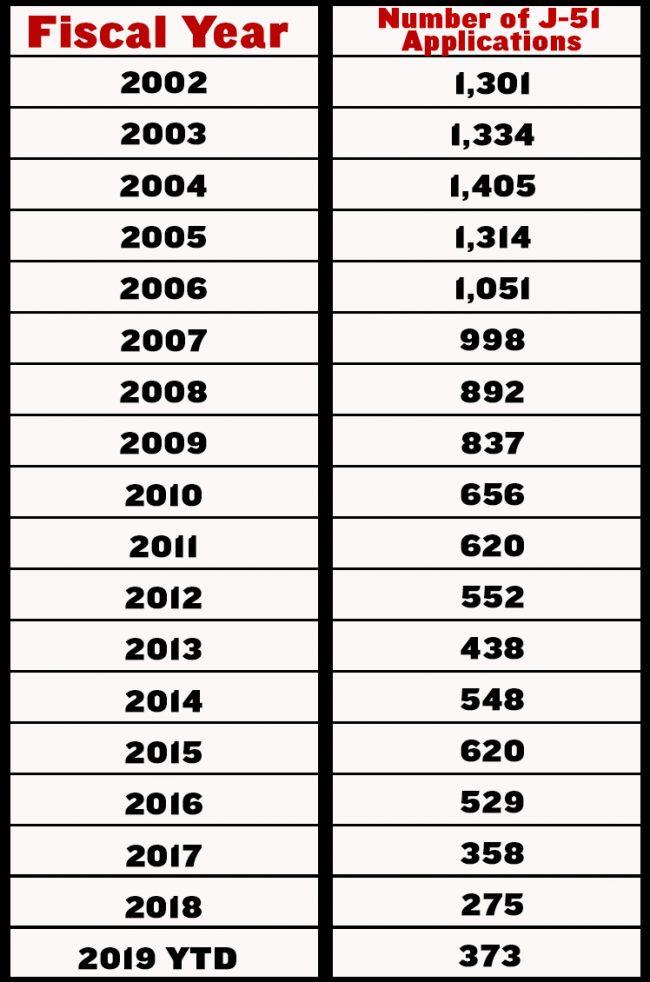Developers usually flock to tax breaks. But there’s one program in New York that’s seeing increasingly less interest from the real estate community.
In the past 10 years applications for J-51 dropped 69 percent, according to data collected by the city’s Department of Housing Preservation and Development. Within the past five years, the volume declined 37 percent, and 23 percent between fiscal years 2017 and 2018. Back in 2004, the city received 1,405 applications — a peak level for the past two decades. In 2018, the agency received only 275 applications, and 373 so far in 2019.
Earlier this month, HPD Commissioner Louise Carroll indicated that the agency was crafting a proposal to overhaul the program, which provides a tax exemption and abatement to owners who renovate their multifamily properties. Carroll said the program needs to be “right sized” to incentivize participation.
“It should be a program that is easier to participate in, offers predictable benefits that are more aligned with the market, and is a useful tool for ensuring housing quality in affordable housing,” an HPD spokesperson said in an email.
Under J-51, tax assessments are frozen at the property’s pre-renovation level for a period of 14 to 34 years. The agency is expected to provide the state legislature with a proposal for how to change the J-51 program by next year.
 Landlord attorneys cite a number of reasons for why the real estate industry has turned away from the program. For one, landlords don’t want to keep their apartments rent stabilized — as is required through the life of the tax break — especially with the passage of the Housing Stability and Tenant Protection Act of 2019. The new law limits when landlords can raise rents on stabilized apartments.
Landlord attorneys cite a number of reasons for why the real estate industry has turned away from the program. For one, landlords don’t want to keep their apartments rent stabilized — as is required through the life of the tax break — especially with the passage of the Housing Stability and Tenant Protection Act of 2019. The new law limits when landlords can raise rents on stabilized apartments.
“They don’t want to re-regulate their units,” said Paul Korngold, a real estate tax attorney and partner at Tuchman, Korngold, Weiss, Liebman & Lindemann. “The benefits for J-51 are really rather small compared to the ability to raise rents.”
Other tax breaks give landlords a bit more leeway to up rents. Affordable New York, formerly known as 421a, lasts for 35 years. Units must remain rent stabilized through the life of that break as well, but owners have the option to deregulate apartments once they become vacant and rent reaches a certain level.
The abatement portion of J-51 is based on the cost of building renovations — 8.3 percent or 12.5 percent of the cost of the work each year for up to 20 years. The total cost, though, is limited by HPD’s Certified Reasonable Cost schedule. According to Korngold and other attorneys, the schedule is woefully out of date, meaning that abatements aren’t being calculated based on the true cost of renovations.
“The costs that would be certified have no relation to reality,” said Alvin Schein, partner at Seiden & Schein.
In recent years, several landlords have been hit with lawsuits accusing them of failing to provide tenants with rent-stabilized leases. Aaron Carr, head of tenant group Housing Rights Initiative, pointed to the 2009 decision finding that Tishman Speyer had wrongly deregulated thousands of apartments at Stuyvesant Town-Peter Cooper Village while receiving J-51. That ruling was a catalyst for the most recent wave of J-51 lawsuits, Carr said.
“From there, real estate’s marriage with J-51 really went to shit,” Carr said. “Real estate’s hatred for rent stabilization became their hatred for J-51.”
Other issues include that eligibility for the program is limited to buildings where the average assessed value per unit is $40,000 for rental units and $30,000 for condos and co-ops. If converting a non-residential property into apartments, a substantial amount of the financing must come from government entities, and critics of the program say it’s increasingly difficult to secure such funds unless the newly converted property is 100 percent affordable.
The drop in J-51 applications may also be a product of uncertainty around how the program will be renewed. The program’s benefits are only approved once construction is completed. Martin Heistein, a partner at Sherwin, Belkin Burden Wenig & Goldman, noted that the application sometimes takes several months to be approved.
“It seems to take longer and longer to get these applications through,” he said. “Either the number of personnel working on the applications has diminished or there are other priorities.”
